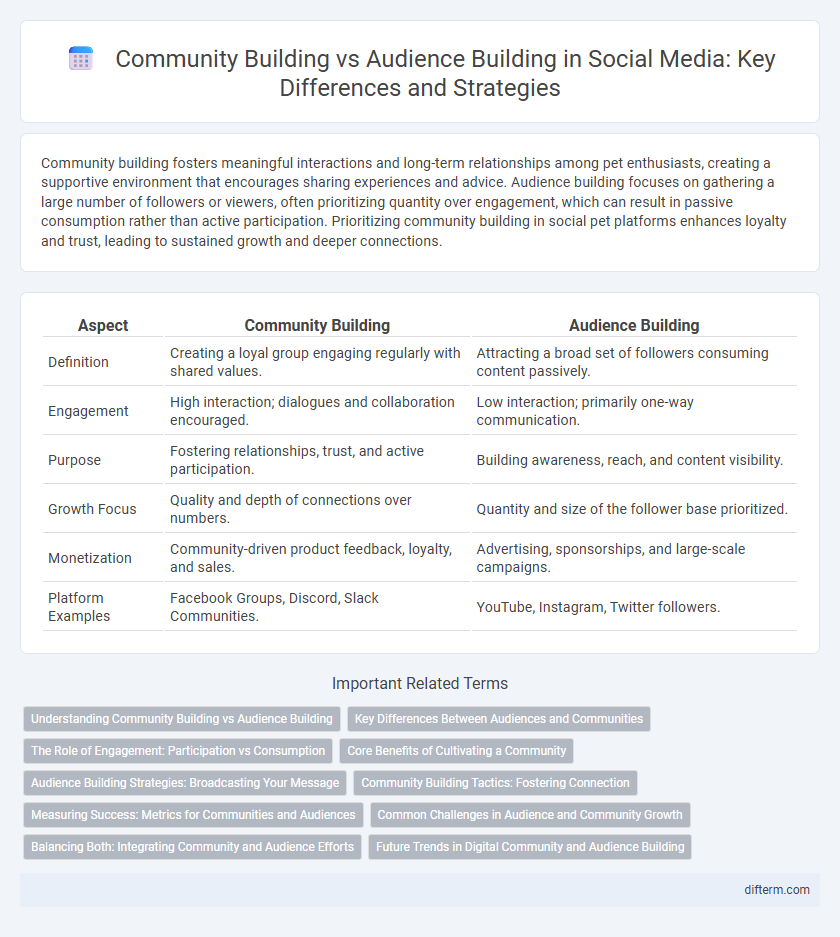Community building fosters meaningful interactions and long-term relationships among pet enthusiasts, creating a supportive environment that encourages sharing experiences and advice. Audience building focuses on gathering a large number of followers or viewers, often prioritizing quantity over engagement, which can result in passive consumption rather than active participation. Prioritizing community building in social pet platforms enhances loyalty and trust, leading to sustained growth and deeper connections.
Table of Comparison
| Aspect | Community Building | Audience Building |
|---|---|---|
| Definition | Creating a loyal group engaging regularly with shared values. | Attracting a broad set of followers consuming content passively. |
| Engagement | High interaction; dialogues and collaboration encouraged. | Low interaction; primarily one-way communication. |
| Purpose | Fostering relationships, trust, and active participation. | Building awareness, reach, and content visibility. |
| Growth Focus | Quality and depth of connections over numbers. | Quantity and size of the follower base prioritized. |
| Monetization | Community-driven product feedback, loyalty, and sales. | Advertising, sponsorships, and large-scale campaigns. |
| Platform Examples | Facebook Groups, Discord, Slack Communities. | YouTube, Instagram, Twitter followers. |
Understanding Community Building vs Audience Building
Community building fosters deep, interactive relationships among members based on shared values and goals, creating a sense of belonging and mutual support. Audience building primarily focuses on gathering a broad group of passive followers interested in consuming content rather than engaging in meaningful dialogue. Understanding this distinction is essential for designing strategies that prioritize long-term engagement and authentic connection over mere numbers.
Key Differences Between Audiences and Communities
Audiences primarily engage passively with content, while communities actively interact and collaborate around shared interests. Communities foster deeper connections and sustained engagement through two-way communication, whereas audiences often experience one-way communication from creators. The key differences lie in engagement depth, interaction frequency, and emotional investment, driving stronger loyalty within communities compared to audiences.
The Role of Engagement: Participation vs Consumption
Community building thrives on active participation, fostering meaningful interactions and shared experiences that create deeper connections among members. Audience building often emphasizes content consumption, where followers engage passively by receiving information without contributing to the dialogue. Engagement in community building transforms users from mere spectators into collaborators, enhancing loyalty and sustaining long-term growth.
Core Benefits of Cultivating a Community
Cultivating a community fosters deep engagement, trust, and long-term loyalty by encouraging meaningful interactions among members with shared interests. Unlike audience building, which emphasizes passive content consumption, communities create dynamic environments that promote collaboration, support, and collective growth. Core benefits include enhanced retention rates, increased user-generated content, and amplified brand advocacy driven by authentic relationships.
Audience Building Strategies: Broadcasting Your Message
Audience building strategies emphasize consistent broadcasting of your message across multiple digital channels such as social media platforms, email newsletters, and podcasts to maximize reach and engagement. Leveraging targeted content creation tailored to specific demographics enhances visibility and fosters a loyal following. Utilizing analytics tools to track audience behavior and preferences refines messaging tactics, ensuring resonant communication and sustained growth.
Community Building Tactics: Fostering Connection
Community building tactics prioritize authentic interaction by encouraging meaningful conversations and shared experiences among members, fostering a strong sense of belonging. Implementing regular events, both virtual and in-person, enhances trust and engagement, transforming passive followers into active participants. Utilizing feedback loops and collaborative projects empowers members, creating a resilient and vibrant community driven by collective purpose.
Measuring Success: Metrics for Communities and Audiences
Community building success is measured by engagement metrics such as active participation rate, member retention, and sentiment analysis, reflecting genuine connections and shared value. Audience building metrics focus on reach and growth indicators like follower count, impressions, and click-through rates, emphasizing scale and visibility. Effective measurement aligns with goals: deeper engagement for communities, broader exposure for audiences.
Common Challenges in Audience and Community Growth
Audience growth often faces challenges such as passive engagement and content saturation, limiting meaningful interaction. Community building struggles with sustaining active participation and fostering genuine connections among members. Both require tailored strategies to balance reach with depth, ensuring long-term loyalty and value exchange.
Balancing Both: Integrating Community and Audience Efforts
Balancing community building and audience building requires blending interactive engagement with content distribution to foster loyalty and reach. Strong communities drive meaningful conversations and long-term relationships, while expansive audiences amplify visibility and influence. Integrating these efforts enhances brand authenticity, sustains growth, and maximizes social impact.
Future Trends in Digital Community and Audience Building
Future trends in digital community and audience building emphasize personalized engagement through AI-driven platforms that foster authentic interactions and long-term loyalty. Immersive technologies like virtual and augmented reality are transforming how communities connect, enabling more vibrant and interactive experiences beyond traditional audience consumption. Data privacy and ethical considerations will increasingly shape platform designs, prioritizing trust and meaningful participation over passive followership.
community building vs audience building Infographic

 difterm.com
difterm.com